The five main trends in the phoneme theory реферат
Обновлено: 06.07.2024
The native speaker doesn’t pay attention to the allophones which don’t change the meaning. But every native speaker has a generalized idea of a complex of distinctive features that can’t be changed without changing the meaning.
The features which can’t be changed without a change of meaning are called relevant (or distinctive)
The invariant of a phoneme – a native speaker’s generalized variants. The invariant of a phoneme is a bundle of its distinctive features.
The functional aspect
.. to dinstinguish the meanings. Phonemes are capable of distinguishing the meaning of words and morphemes: seemed [d] ó seems [z]
and changing the meanings of whole sentences:
Ex: He was heard badly. – He was hurt badly.
There is no room for you in my hut. – There is no room for you in my heart.
This function is performed when the phoneme is opposed to another phoneme in the same phonetic context: [ka:t] – [pa:t]
backlingual bilabial (relevant features)
The features that do not effect the meaning are called irrelevant features (non-distinctive). Ex: aspiration.
Distinctive features for English consonants:
1) place of articulation;
2) manner of articulation;
3) absence/ presence of voice
Distinctive features for English vowels:
1) the vowel quality: [sit] – [si:t]
Phonetic and Phonological Mistakes:
If an allophone of some phoneme is replaced by an allophone of a different phoneme – the mistake is phonological.
If an allophone of some phoneme is replaced by another allophone of the same phoneme – the mistake is called phonetic.
The phoneme is a unity of 3 aspects: material, abstract and function.
Transcription and phonetic notations.
Transcription is a set of symbols which represents sounds in written form.
There is an organization called IPA (International Phonetic Assosiation), and it worked out the system of symbols universal internationally: International Phonetic Alphabet (IPA).
There are 2 types of transcription: broad and narrow.
The broad variant is (called) phonemic and provides symbols for the phonemes. It’s used in teaching.
The narrow variant is (called) allophonic and provides symbols for the allophones, mainly used in phonetic research: [p h ] – aspiration, seemed – [d o ] partly devoiced.
There are 2 types of broad transcription: by D.Jones and by Vasiliev.
By D.Jones: uses the same symbols for short and long vowels (he focused on the length, but it’s a non-distinctive feature).
By Vasiliev: uses special symbols for all vowel phonemes.
Phoneme Theory. Part II
Main trends in the phoneme theory. The history of investigation.
The phoneme is one of the basic language units. However, by different linguistic schools it’s very differently described.
The history of phonological studies.
The idea of distinguishing between the functional approach to the study of speech sounds and their material substance was first expressed by the Russian linguist Ivan Alexandrovich Бодуэн-де-Куртене (he is the founder).
in the 20-30s of the 20 th century a number of phonological conceptions appeared in different countries.
Nickolai Trubetskoy (Prague Linguistic Circle)
The theory of these two linguists formed the classical phonology (in Europe).
in the USA at the same time the familiar theories appeared.
There were 2 famous schools in Russia: Leningrad School (Scherba, his follower Зиндер, Бондаренко - woman) and Moscow School (Avanesov, Кузнецов, Реформатский).
Among American linguists: E. Sapir – classical phonology.
All these theories are classical, traditional, static (description, classificatory character).
In the 60s of the 20 th century New Phonology appeared. It was aimed to explain how speech was actually produced and understood.
This New Phonology is known as generative phonology.
N. Chomsky (an American linguist)
They tried to create dynamic models, which were aimed at establishing the sound pattern of a sentence on the basis of its semantic and grammar characteristics.
The main criterion is the approach of different linguistics to the 3 aspects of the phoneme. Some linguists exaggerated the material aspect, some – the abstract one and etc.
Groups of Conceptions
1) includes the conception that pay special attention to the abstract aspect. This vie is called mentalistic or psychological. According to it, the phoneme is the ideal mental image, it doesn’t exist objectively, it exists only in the mind of the speaker. Actual speech sounds are an imperfect realization of the phoneme. These ideas were expressed by Бодуэн-де-Куртене and later developed by Sapir and others.
2) functional group conception. Because special attention is given to the ability of the phoneme to differentiate the meaning. Scholars are particularly interested in distinctive features, while non-distinctive features are often ignored.
Trubetskoy, Jakobson and Bloomfield.
The greatest achievement of these scholars was that their theory gave rise to phonology as a linguistic discipline. However it resulted in the separation of phonetics and phonology. They claimed that only phonology was a linguistic discipline, while phonetics should belong to biology. The material aspect was ignored by this theory.
3) the material aspect is exaggerated. This approach is called physical and is represented by D. Johnes and an American scholar B. Bloch. And they regarded the phoneme as the family of sounds, i.e. the phoneme is a mechanical sum of its allophones. So, similarity between sounds is considered to be the main criterion for attributing them to a particular phoneme. They ignored abstract and functional aspects.
It also demonstrates, that Scherba’s definition is comprehensive, because it gives equal importance to each of the aspects of the phoneme.











Слайд 1

Слайд 2
PHYSICAL VIEW A phoneme may be described roughly as a family of sounds consisting of an important sound of the language (generally the most frequently used member of that family) together with other related sounds which 'take its place' in particular sound-sequences or under particular conditions of length or stress or intonation. – Daniel Jones, “An Outline of English Phonetics”

Слайд 3
PHYSICAL VIEW A phoneme is a class of phonetically similar sounds, contrasting and mutually exclusive with all similar classes in the language. – B. Bloch and G. Trager
![Lena cleans a pool. Lena cleans a pool. [lʲi:nə klʲ˳i:nz ə pʰu:ɫ] lʲ, lʲ˳, ɫ - members of the “family” of the phoneme /l/.](https://mypresentation.ru/documents_5/ca3923503d73cd4e1f92eec95c8457e5/img3.jpg)
Слайд 4
Lena cleans a pool. Lena cleans a pool. [lʲi:nə klʲ˳i:nz ə pʰu:ɫ] lʲ, lʲ˳, ɫ - members of the “family” of the phoneme /l/.

Слайд 5

Слайд 6

Слайд 7

Слайд 8
R. Jakobson AND M. Halle DISTINCTIVE FEATURE THEORY All features are privative (i.e. binary). There is a difference between phonetic and phonological features: distinctive features are phonological. phonetic features are surface realizations of underlying phonological features. A small set of features is able to differentiate between the phonemes of any single language. Distinctive features may be defined in terms of articulatory or acoustic features.

Слайд 9

Слайд 10
Слайды и текст этой презентации
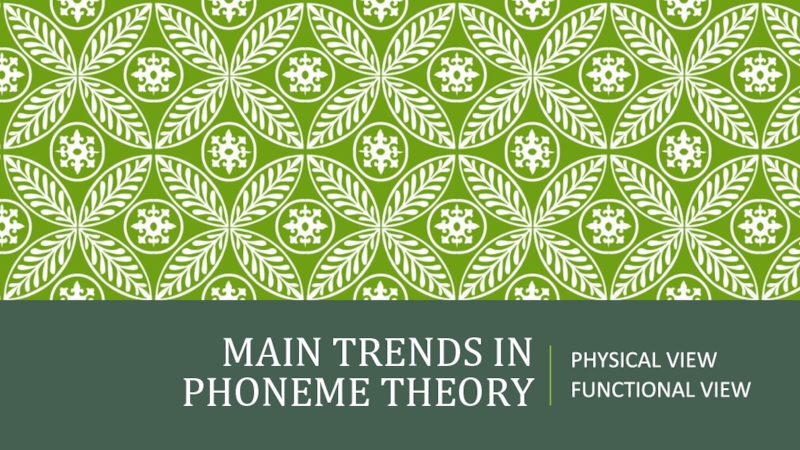
MAIN TRENDS IN PHONEME THEORY
PHYSICAL VIEW
FUNCTIONAL VIEW
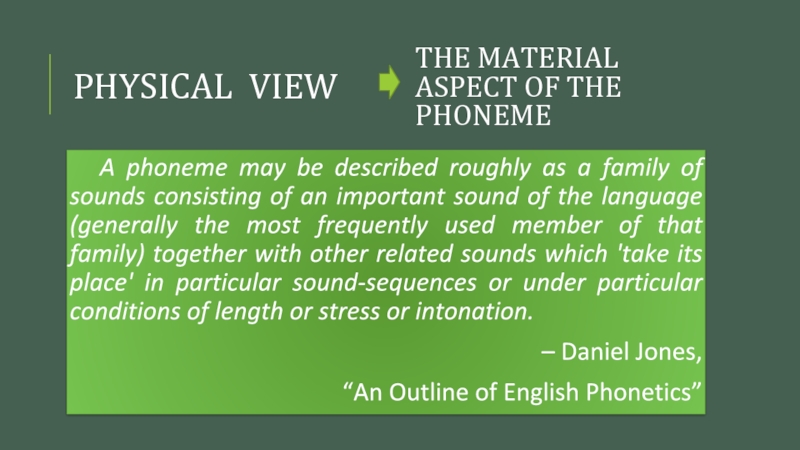
A phoneme may be described roughly as a family of sounds consisting of an important sound of the language (generally the most frequently used member of that family) together with other related sounds which 'take its place' in particular sound-sequences or under particular conditions of length or stress or intonation.
– Daniel Jones,
“An Outline of English Phonetics”
THE MATERIAL ASPECT OF THE PHONEME
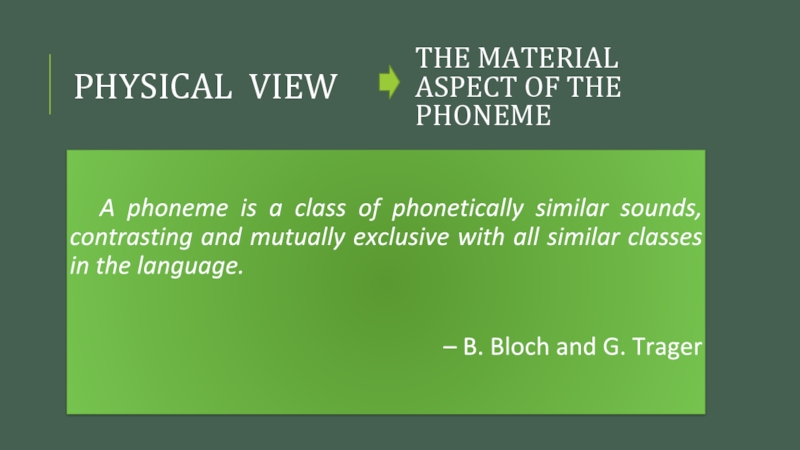
A phoneme is a class of phonetically similar sounds, contrasting and mutually exclusive with all similar classes in the language.
– B. Bloch and G. Trager
THE MATERIAL ASPECT OF THE PHONEME
![Lena cleans a pool.[lʲi:nə klʲ˳i:nz ə pʰu:ɫ]lʲ, lʲ˳, ɫ - members of the “family” of the phoneme](https://theslide.ru/img/thumbs/a00ab8b9e8d30c7e5919509c418d8381-800x.jpg)
Lena cleans a pool.
[lʲi:nə klʲ˳i:nz ə pʰu:ɫ]
lʲ, lʲ˳, ɫ - members of the “family” of the phoneme /l/.
PHONETIC CONTEXT:
LIGHT [l] – BEFORE VOWELS
DARK [ɫ] – BEFORE CONSONANTS AND WORD-FINALLY
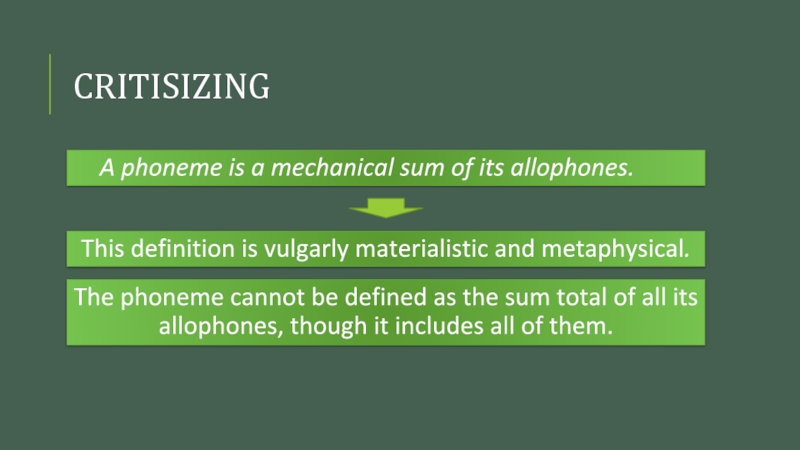
A phoneme is a mechanical sum of its allophones.
This definition is vulgarly materialistic and metaphysical.
The phoneme cannot be defined as the sum total of all its allophones, though it includes all of them.
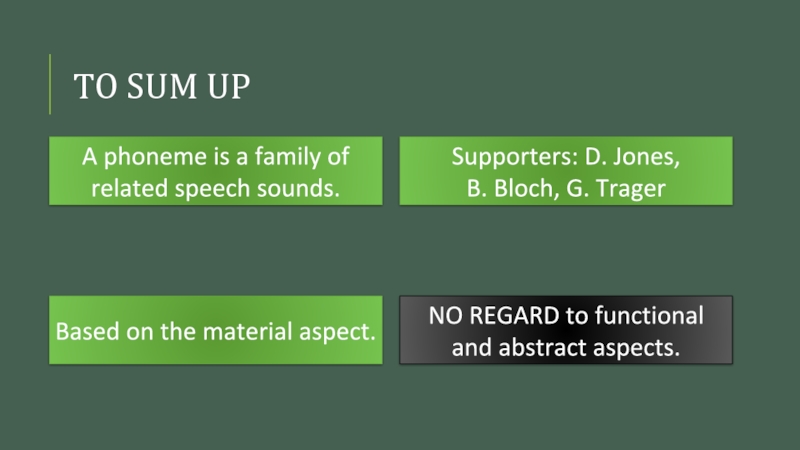
A phoneme is a family of related speech sounds.
Supporters: D. Jones, B. Bloch, G. Trager
Based on the material aspect.
NO REGARD to functional and abstract aspects.
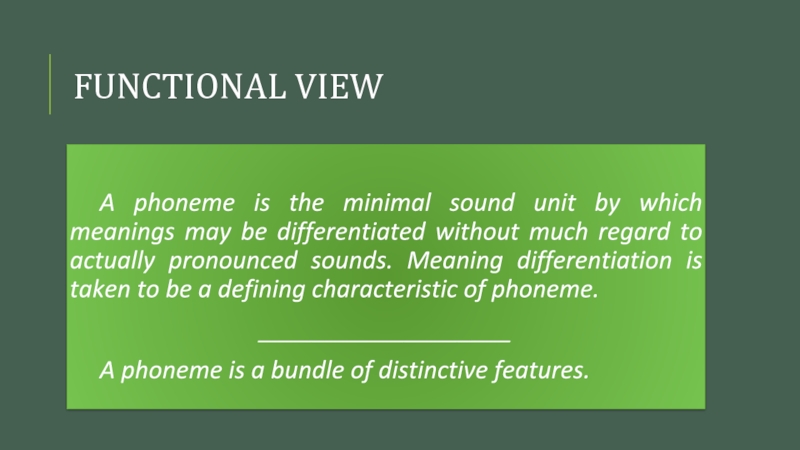
A phoneme is the minimal sound unit by which meanings may be differentiated without much regard to actually pronounced sounds. Meaning differentiation is taken to be a defining characteristic of phoneme.
___________________
A phoneme is a bundle of distinctive features.
Вы можете изучить и скачать доклад-презентацию на тему The Phoneme. Презентация на заданную тему содержит 17 слайдов. Для просмотра воспользуйтесь проигрывателем, если материал оказался полезным для Вас - поделитесь им с друзьями с помощью социальных кнопок и добавьте наш сайт презентаций в закладки!

















Phonology Phonology is a branch of Phonetics which investigates sounds of speech, as units which serve people for communicative purposes. In real speech we pronounce a great variety of sounds, some of the sounds help to differentiate words, because they are different phonologically. Their interchange changes the meaning of the words and interferes with communication. E.g. /pɪl/, /bɪl/.
At the same time there are sounds which partially differ in articulation and acoustic value, but they don't differ phonologically. They can't differentiate words and their substitution does not interfere with communication it only causes a foreign accent, e.g. pill – aspiration, spill – less aspiration, slipper – p – partially voiced.
The first type of sounds which is phonologically important is phonemes. Every language has a limited number of sound types or phonemes, they are shared by all the native speakers of the language and they are linguistically important because they distinguish words. In English there are 20 vowel phonemes and 24 consonant phonemes (6 vowels, 35 consonants – Russian).
In actual speech sounds pronounced by speakers are variants of the phonemes existing in the language. These really pronounced variants are called allophones /vaɪn/ - /waɪn/ Allophones are sounds that cannot distinguish words in a definite language, they occur only in certain positions or in combination with certain sounds, they are realizations of one and the same phoneme. /l/ - [kɔ:l] – dark variant- [laɪt] – light variant
There are several conceptions of the phoneme among Russian and foreign linguists and none of them is satisfactory from all points of view. There are several conceptions of the phoneme among Russian and foreign linguists and none of them is satisfactory from all points of view. The difficulty of giving such a definition lies in the fact that the Phoneme has several aspects and functions. That's why it's impossible to give a formal definition in a single sentence that would reflect all the aspects and functions. Professor Vasilyev suggests a rather short working definition: the Phoneme is the smallest further indivisible into small segments language unit that exists in the speech of all the members of a given language community as such speech sounds, which are capable of distinguishing one word from another word of the same language or one grammatical form of a word from another grammatical form of the same word.
The Phoneme is a dialectical unity of 3 aspects reflected in the above mentioned definition. The 1st aspect: the Phoneme is material, real and objective; 2nd aspect: the Phoneme is abstractional and generalized; 3rd aspect: the Phoneme is also a functional unit. The 3 aspects are interconnected and they determine one another.
1st aspect. Material, real and objective. A phoneme has a material aspect in the sense that it is represented by concrete material sounds. And that is its allophones. In other words the phoneme exists in speech in the material form of speech sounds. What is material is at the same time real. The phoneme is a linguistic reality, because it exists in actual speech. The phoneme is objective, because it exists independently of the will of individuals.
2nd aspect. Abstractional and generalized. The phoneme is abstracted from its allophones, but at the same time its characterized by the features common to all of them. E.g. /b/ - occlusive, bilabial, lenis, some allophones can be partially devoiced, can lose bilabial character, but most important characteristics remain.
Distinctive function consists in the differenciation of the language units higher than the phoneme itself. The distinctive function of the phoneme may be subdivided into the following: 1) morpheme-distinctive (teach – teacher), 2) word or form distinctive (/pen/ - /ten/, ask - asks); 3) sentence-distinctive (It was cold. It was gold. It was bold). The distinctive function is the principle function of the phoneme. Distinctive function consists in the differenciation of the language units higher than the phoneme itself. The distinctive function of the phoneme may be subdivided into the following: 1) morpheme-distinctive (teach – teacher), 2) word or form distinctive (/pen/ - /ten/, ask - asks); 3) sentence-distinctive (It was cold. It was gold. It was bold). The distinctive function is the principle function of the phoneme. Constitutive function. Though the phoneme in isolation has no meaning, it is linguistically important because in its material form it constitutes words, morphemes which are meaningful. Recognitive (identificatory) function. The recognitive function consists in making words with their grammatical forms and then whole sentences easily recognizable as the result of the use of the right phoneme in the right place.
The Phoneme Theory The phoneme theory came into being in Russia. It was founded by professor I.A. Baudoin de Courtenay (1845 – 1929), who was the founder of the Kazan linguistic school. The fundamental principles of the phoneme theory were worked out by him during the 1870s. According to his theory a speech sound is a sound of a definite acoustic quality, produced by the organs of speech. Any given speech sound is incapable of variation. A Phoneme is defined by him as a group of related sounds of a given language, which are so used in connected speech, that no one of them ever occurs in positions, which any other can occupy. Speech sounds which belong to the same phoneme cannot distinguish one word from another, but phonemes distinguish one word from another in the same language.
Baudoin de Courtenay's point of view was later developed by his disciple Lev Scherba (1880 – 1944). Baudoin de Courtenay's point of view was later developed by his disciple Lev Scherba (1880 – 1944). He separated phonetics from phonology and stated that sounds are not only articulatory and acoustic units, but they also possess functional qualities. In every language all these sounds are united in a comparatively small number of sound types. This sound types are capable of distinguishing meanings and forms of words. They serve the purpose of social intercourse. These sound types are called phonemes. And the actual speech sounds that we pronounce and the individual representing the universal are called phonemic variant or allophones. Scherba's conception is a truly materialistic theory of the phoneme. He was the first to define the phoneme as a real independent distinctive unit, which manifests itself in the form of its allophones.
There are some other views on the nature of the phoneme. From physical point of view the phoneme is a family of related sounds in which various members of the family must show articulatory similarity to one another and at the same time no member of the family may occur in the same phonetic context. There are some other views on the nature of the phoneme. From physical point of view the phoneme is a family of related sounds in which various members of the family must show articulatory similarity to one another and at the same time no member of the family may occur in the same phonetic context. This approach overestimates the material aspect of the phoneme since it views the phoneme as a group of articulatory similar sounds without any regard to its functional and abstract aspects. The physical point of view was put forward by Daniel Johnes, he was the head of London school of phonology. A similar approach is expressed by the French linguist Ferdinant de Saussure. He viewed the phoneme as a sum of acoustic impressions and articulatory movements.
The opposite approach is reflected in the so-called functional view. It regards the phoneme as the minimal sound unit by which meanings may be differenciated without much regard to actually pronounced speech sounds. According to this conception the phoneme is not a family of sounds since in every sound not all the articulatory features are involved in the differenciation of meanings. Only the features helping differenciate meanings are called distinctive and they make the phoneme corresponding to them. That's why the approach excludes non-distinctive features from the phoneme. The opposite approach is reflected in the so-called functional view. It regards the phoneme as the minimal sound unit by which meanings may be differenciated without much regard to actually pronounced speech sounds. According to this conception the phoneme is not a family of sounds since in every sound not all the articulatory features are involved in the differenciation of meanings. Only the features helping differenciate meanings are called distinctive and they make the phoneme corresponding to them. That's why the approach excludes non-distinctive features from the phoneme. The approach was first expressed by Nikolay Trubetskoy, the head of the Prague linguistic school. He defines phoneme as a unity of phonologically relevant features. He wrote that when the phoneme is neutralized it becomes an archiphoneme, which is an abstraction combining the distinctive features common to two phonemes (лук — луг, k and g are one archiphoneme). According to his view-point both 'k' and 'g' in the Russian words 'luk' and 'lug' represent the archiphoneme 'k', which is neither voiced, nor voiceless. A similar view is expressed by American phoneticians, who define the phoneme as a bunch of distinctive features and as an abstractional fiction.
Читайте также:
- Актуальность фантастических образов н в гоголя для современной россии реферат
- Устройства связи с объектом аналого цифровые и цифро аналоговые преобразователи реферат
- Промышленные подземные воды реферат
- Интернет зависимость как вид аддиктивного поведения реферат
- Реферат на тему чрезвычайные ситуации экологического характера связанные с загрязнением атмосферы

